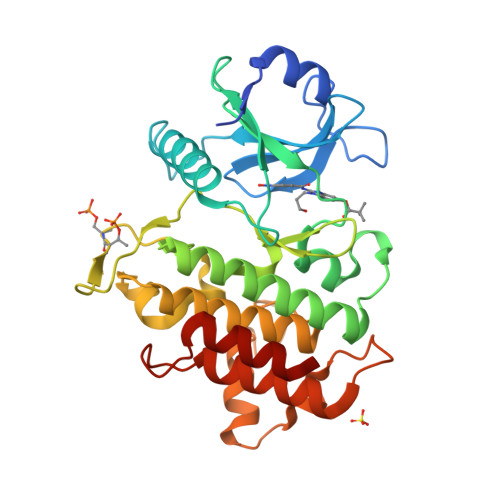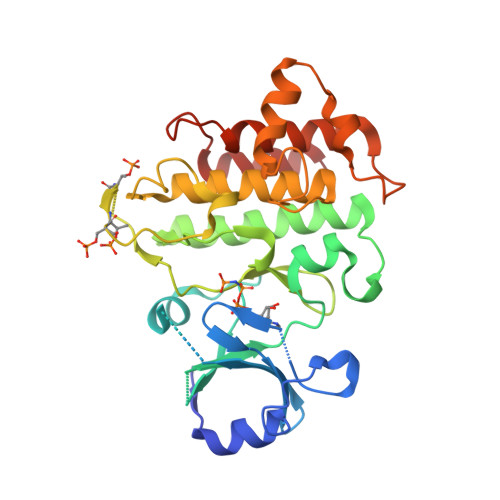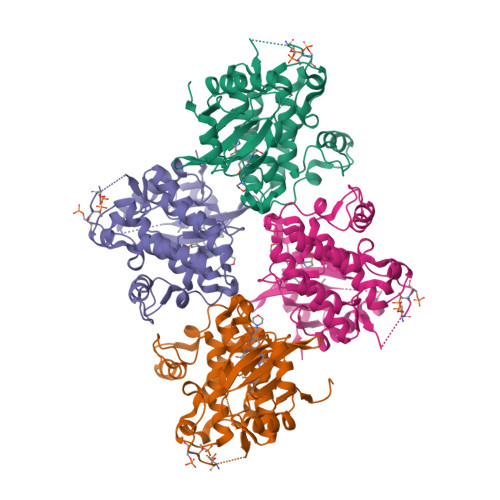GtoPdb is requesting financial support from commercial users. Please see our sustainability page for more information.
interleukin 1 receptor associated kinase 4
 Target has curated data in GtoImmuPdb
Target has curated data in GtoImmuPdb
Target id: 2045
Nomenclature: interleukin 1 receptor associated kinase 4
Abbreviated Name: IRAK4
Family: Interleukin-1 receptor-associated kinase (IRAK) family
Contents:
Gene and Protein Information  |
||||||
| Species | TM | AA | Chromosomal Location | Gene Symbol | Gene Name | Reference |
| Human | - | 460 | 12q12 | IRAK4 | interleukin 1 receptor associated kinase 4 | |
| Mouse | - | 459 | 15 E3 | Irak4 | interleukin-1 receptor-associated kinase 4 | |
| Rat | - | 461 | 7q35 | Irak4 | interleukin-1 receptor-associated kinase 4 | |
Previous and Unofficial Names  |
| Renal carcinoma antigen NY-REN-64 | interleukin-1 receptor-associated kinase 4 |
Database Links  |
|
| Alphafold | Q9NWZ3 (Hs), Q8R4K2 (Mm), D4A7K4 (Rn) |
| BRENDA | 2.7.11.1 |
| ChEMBL Target | CHEMBL3778 (Hs), CHEMBL4630844 (Mm), CHEMBL4105995 (Rn) |
| Ensembl Gene | ENSG00000198001 (Hs), ENSMUSG00000059883 (Mm), ENSRNOG00000005965 (Rn) |
| Entrez Gene | 51135 (Hs), 266632 (Mm), 300177 (Rn) |
| Human Protein Atlas | ENSG00000198001 (Hs) |
| KEGG Enzyme | 2.7.11.1 |
| KEGG Gene | hsa:51135 (Hs), mmu:266632 (Mm), rno:300177 (Rn) |
| OMIM | 606883 (Hs) |
| Orphanet | ORPHA122674 (Hs) |
| Pharos | Q9NWZ3 (Hs) |
| RefSeq Nucleotide | NM_001114182 (Hs), NM_029926 (Mm), NM_001106791 (Rn) |
| RefSeq Protein | NP_001107654 (Hs), NP_084202 (Mm), NP_001100261 (Rn) |
| SynPHARM | 84577 (in complex with PF-06650833) |
| UniProtKB | Q9NWZ3 (Hs), Q8R4K2 (Mm), D4A7K4 (Rn) |
| Wikipedia | IRAK4 (Hs) |
Selected 3D Structures  |
|||||||||||||

|
|
||||||||||||

|
|
||||||||||||

|
|
||||||||||||

|
|
||||||||||||
Enzyme Reaction  |
||||
|
||||
Download all structure-activity data for this target as a CSV file 
| Inhibitors | |||||||||||||||||||||||||||||||||||||||||||||||||||||||||||||||||||||||||||||||||||||||||||||||||||||||||||||||||||||||||||||||||||||||||||||||||||||||||||||||||||||||||||||||||||||||||||||||||||||||||||||||||||||||||||||||||||||||||||||||||||||||||||||||||||||||||||||||||||||||||||||||||||||||||||||||||||||||||||||||||||||||||||||||||||||||||||||||||||||||||||||||||||||||||||||||||||||||||||||||||||||||||||||||||||||||||||||||||||||||||||||||||||||||||||||||||||||||||||||||||||||||||||||||||||||||||||||||||||||||||||||||||||||||||||||||||||||||||||||||||||||||||||||||||||||||||||||||||||||||||||||||||||||||||||||||||||
| Key to terms and symbols | View all chemical structures | Click column headers to sort | |||||||||||||||||||||||||||||||||||||||||||||||||||||||||||||||||||||||||||||||||||||||||||||||||||||||||||||||||||||||||||||||||||||||||||||||||||||||||||||||||||||||||||||||||||||||||||||||||||||||||||||||||||||||||||||||||||||||||||||||||||||||||||||||||||||||||||||||||||||||||||||||||||||||||||||||||||||||||||||||||||||||||||||||||||||||||||||||||||||||||||||||||||||||||||||||||||||||||||||||||||||||||||||||||||||||||||||||||||||||||||||||||||||||||||||||||||||||||||||||||||||||||||||||||||||||||||||||||||||||||||||||||||||||||||||||||||||||||||||||||||||||||||||||||||||||||||||||||||||||||||||||||||||||||||||||||
|
|||||||||||||||||||||||||||||||||||||||||||||||||||||||||||||||||||||||||||||||||||||||||||||||||||||||||||||||||||||||||||||||||||||||||||||||||||||||||||||||||||||||||||||||||||||||||||||||||||||||||||||||||||||||||||||||||||||||||||||||||||||||||||||||||||||||||||||||||||||||||||||||||||||||||||||||||||||||||||||||||||||||||||||||||||||||||||||||||||||||||||||||||||||||||||||||||||||||||||||||||||||||||||||||||||||||||||||||||||||||||||||||||||||||||||||||||||||||||||||||||||||||||||||||||||||||||||||||||||||||||||||||||||||||||||||||||||||||||||||||||||||||||||||||||||||||||||||||||||||||||||||||||||||||||||||||||||
| View species-specific inhibitor tables | |||||||||||||||||||||||||||||||||||||||||||||||||||||||||||||||||||||||||||||||||||||||||||||||||||||||||||||||||||||||||||||||||||||||||||||||||||||||||||||||||||||||||||||||||||||||||||||||||||||||||||||||||||||||||||||||||||||||||||||||||||||||||||||||||||||||||||||||||||||||||||||||||||||||||||||||||||||||||||||||||||||||||||||||||||||||||||||||||||||||||||||||||||||||||||||||||||||||||||||||||||||||||||||||||||||||||||||||||||||||||||||||||||||||||||||||||||||||||||||||||||||||||||||||||||||||||||||||||||||||||||||||||||||||||||||||||||||||||||||||||||||||||||||||||||||||||||||||||||||||||||||||||||||||||||||||||||
| Other Binding Ligands | |||||||||||||||||||||||||||||||||||||||||||||||||||
| Key to terms and symbols | Click column headers to sort | ||||||||||||||||||||||||||||||||||||||||||||||||||
|
|||||||||||||||||||||||||||||||||||||||||||||||||||
DiscoveRx KINOMEscan® screen  |
|||||||||||||||||||||||||||||||||||||||||||||||||||||||||||||||||||||||||||||||||||||||||||||||||||||||||||||||||||||||||||||||||||||||||||||||||||||||||||||||||||||||
|
A screen of 72 inhibitors against 456 human kinases. Quantitative data were derived using DiscoveRx KINOMEscan® platform. http://www.discoverx.com/services/drug-discovery-development-services/kinase-profiling/kinomescan Reference: 13,33 |
 
|
||||||||||||||||||||||||||||||||||||||||||||||||||||||||||||||||||||||||||||||||||||||||||||||||||||||||||||||||||||||||||||||||||||||||||||||||||||||||||||||||||||||
| Key to terms and symbols | Click column headers to sort | ||||||||||||||||||||||||||||||||||||||||||||||||||||||||||||||||||||||||||||||||||||||||||||||||||||||||||||||||||||||||||||||||||||||||||||||||||||||||||||||||||||||
| Target used in screen: IRAK4 | |||||||||||||||||||||||||||||||||||||||||||||||||||||||||||||||||||||||||||||||||||||||||||||||||||||||||||||||||||||||||||||||||||||||||||||||||||||||||||||||||||||||
|---|---|---|---|---|---|---|---|---|---|---|---|---|---|---|---|---|---|---|---|---|---|---|---|---|---|---|---|---|---|---|---|---|---|---|---|---|---|---|---|---|---|---|---|---|---|---|---|---|---|---|---|---|---|---|---|---|---|---|---|---|---|---|---|---|---|---|---|---|---|---|---|---|---|---|---|---|---|---|---|---|---|---|---|---|---|---|---|---|---|---|---|---|---|---|---|---|---|---|---|---|---|---|---|---|---|---|---|---|---|---|---|---|---|---|---|---|---|---|---|---|---|---|---|---|---|---|---|---|---|---|---|---|---|---|---|---|---|---|---|---|---|---|---|---|---|---|---|---|---|---|---|---|---|---|---|---|---|---|---|---|---|---|---|---|---|---|---|
|
|||||||||||||||||||||||||||||||||||||||||||||||||||||||||||||||||||||||||||||||||||||||||||||||||||||||||||||||||||||||||||||||||||||||||||||||||||||||||||||||||||||||
| Displaying the top 10 most potent ligands View all ligands in screen » | |||||||||||||||||||||||||||||||||||||||||||||||||||||||||||||||||||||||||||||||||||||||||||||||||||||||||||||||||||||||||||||||||||||||||||||||||||||||||||||||||||||||
EMD Millipore KinaseProfilerTM screen/Reaction Biology Kinase HotspotSM screen  |
||||||||||||||||||||||||||||||||||||||||||||||||||||||||||||||||||||||||||||||||||||||||||||||||||||||||||||||||||||||||||||||||||||||||||||||||||||||||||||||||||||||||
|
A screen profiling 158 kinase inhibitors (Calbiochem Protein Kinase Inhibitor Library I and II, catalogue numbers 539744 and 539745) for their inhibitory activity at 1µM and 10µM against 234 human recombinant kinases using the EMD Millipore KinaseProfilerTM service. A screen profiling the inhibitory activity of 178 commercially available kinase inhibitors at 0.5µM against a panel of 300 recombinant protein kinases using the Reaction Biology Corporation Kinase HotspotSM platform. http://www.millipore.com/techpublications/tech1/pf3036 http://www.reactionbiology.com/webapps/main/pages/kinase.aspx Reference: 2,17 |
 
|
|||||||||||||||||||||||||||||||||||||||||||||||||||||||||||||||||||||||||||||||||||||||||||||||||||||||||||||||||||||||||||||||||||||||||||||||||||||||||||||||||||||||
| Key to terms and symbols | Click column headers to sort | |||||||||||||||||||||||||||||||||||||||||||||||||||||||||||||||||||||||||||||||||||||||||||||||||||||||||||||||||||||||||||||||||||||||||||||||||||||||||||||||||||||||
| Target used in screen: IRAK4/IRAK4 | ||||||||||||||||||||||||||||||||||||||||||||||||||||||||||||||||||||||||||||||||||||||||||||||||||||||||||||||||||||||||||||||||||||||||||||||||||||||||||||||||||||||||
|---|---|---|---|---|---|---|---|---|---|---|---|---|---|---|---|---|---|---|---|---|---|---|---|---|---|---|---|---|---|---|---|---|---|---|---|---|---|---|---|---|---|---|---|---|---|---|---|---|---|---|---|---|---|---|---|---|---|---|---|---|---|---|---|---|---|---|---|---|---|---|---|---|---|---|---|---|---|---|---|---|---|---|---|---|---|---|---|---|---|---|---|---|---|---|---|---|---|---|---|---|---|---|---|---|---|---|---|---|---|---|---|---|---|---|---|---|---|---|---|---|---|---|---|---|---|---|---|---|---|---|---|---|---|---|---|---|---|---|---|---|---|---|---|---|---|---|---|---|---|---|---|---|---|---|---|---|---|---|---|---|---|---|---|---|---|---|---|---|
|
||||||||||||||||||||||||||||||||||||||||||||||||||||||||||||||||||||||||||||||||||||||||||||||||||||||||||||||||||||||||||||||||||||||||||||||||||||||||||||||||||||||||
| Displaying the top 10 most potent ligands View all ligands in screen » | ||||||||||||||||||||||||||||||||||||||||||||||||||||||||||||||||||||||||||||||||||||||||||||||||||||||||||||||||||||||||||||||||||||||||||||||||||||||||||||||||||||||||
| Immunopharmacology Comments |
| IRAK4 is essential for most innate immune responses to bacteria and viruses, and IRAK4 deficiency (caused by mutations) has been shown to result in recurrent invasive pneumococcal disease [24]. The mechanistic explanation for IRAK4's importance is revealed in this proteins central role in TLR/IL-1R superfamily signalling (this superfamily of proteins includes the Toll-like receptors and receptors for pro-inflammatory cytokines IL-1 and IL-18, which all share a Toll/IL-1R homology (TIR) domain in their intracellular region). Signalling via TIR-containing receptors depends on the formation of a multi-protein complex termed the Myddosome, so-named as hierarchical complex formation begins with recruitment of the TIR-containing adaptor protein MyD88 [26]. MyD88 recruits IRAK4 and this complex further recruits the IRAK4 substrates IRAK2 or the related IRAK1 [23]. Formation of the Myddosome brings the IRAK kinase domains in to proximity, facilitating phosphorylation and activation and ultimately activation of transcription factors NF-κB, AP-1 and IRFs (e.g. IRF5 [12]) to stimulate anti-pathogen responses and inflammation [15,25]. The development of clinically useful IRAK4 inhibitors is underway, with investigational indications including autoimmune and inflammatory diseases, and cancer. Lead compounds in development pipelines include BMS-986126, ND-346 and CA-4948 which are being considered as therapuetics for SLE, lymphomas and other malignancies [14,19]. However, any preclinical assessment should address the relevance of IRAK4 splice variants which may influence inhibitor selectivity and/or expression profile, as well as considering the side effects of inhibiting such a crucial enzyme. Other areas for potential development include: Cardiac inflammation and damage (TLR4 activation in response to ischaemia), CNS and neuropathic pain (TLR4 receptors are upregulated in neuropathic pain and in neuroinflammatory states, particularly on microglia) [9], asthma [11], multiple sclerosis and other Th17-driven immunological conditions [29]. As an alternative to IRAK4 inhibition, Kymera Therapeutics have developed an orally delivered IRAK4 selective ubiquitin-mediated protein degrader molecule (KT-474) that they are initially progressing for atopic dermatitis and hidradenitis suppurativa (see NCT04772885). KT-474 is designed to block IRAK4-mediated inflammatory signalling in two independent ways; 1) inhibiting IRAK4 kinase activity and, 2) disrupting its scaffold function in myddosome assembly. KT-474 offers clinical potential beyond dermatologic indications, such as in rheumatic, respiratory and gastrointestinal inflammatory diseases. KT-474 is the first molecular degrader class drug to enter clinical development for non-oncology indications. |
Clinically-Relevant Mutations and Pathophysiology 
|
||||||||||||
|
||||||||||||
|
||||||||||||
References
1. Ammann S, Bacon EM, Brisgys G, Chin E, Chou C, Cottell JJ, Ndukwe M, Taylor JG, Wright NE, Yang ZY et al.. (2020) Pyrrolo[1,2-b] pyridazine derivatives. Patent number: WO2020014468A1. Assignee: Gilead Sciences, Inc.. Priority date: 13/07/2018. Publication date: 16/01/2020.
2. Anastassiadis T, Deacon SW, Devarajan K, Ma H, Peterson JR. (2011) Comprehensive assay of kinase catalytic activity reveals features of kinase inhibitor selectivity. Nat Biotechnol, 29 (11): 1039-45. [PMID:22037377]
3. Anderson DR, Bunnage ME, Curran KJ, Dehnhardt CM, Gavrin LK, Goldberg JA, Han S, Hepworth D, Huang H-C, Lee A et al.. (2015) Bicyclic-fused heteroaryl or aryl compounds and their use as IRAK4 inhibitors. Patent number: WO2015150995. Assignee: Pfizer Inc.. Priority date: 04/04/2014. Publication date: 08/10/2015.
4. Arora N, Chen S, Hermann JC, KuglstatterA, Labadie SS, Lin CJJ, Lucas MC, Moore AG, Papp E, Talamas FX et al.. (2012) Pyrazolo [1, 5a] pyrimidine and thieno [3, 2b] pyrimidine derivatives as irak4 modulators. Patent number: WO2012007375. Assignee: F. Hoffmann-La Roche Ag. Priority date: 13/11/2015. Publication date: 19/01/2012.
5. Bothe U, Günther J, Nubbemeyer R, Siebeneicher H, Ring S, Bömer U, Peters M, Rausch A, Denner K, Himmel H et al.. (2024) Discovery of IRAK4 Inhibitors BAY1834845 (Zabedosertib) and BAY1830839. J Med Chem, 67 (2): 1225-1242. [PMID:38228402]
6. Bothe U, Siebenreicher H, Schmidt N, Nubbemeyer R,Bomer U, Gunther J, Steuber H, Lange M, Stegmann C, Sutter A, Rausch A. (2016) New substituted indazoles, methods for the production thereof, pharmaceutical preparations that contain said new substituted indazoles, and use of said new substituted indazoles to produce drugs. Patent number: WO2016083433A1. Assignee: Bayer Pharma. Priority date: 26/11/2014. Publication date: 02/02/2016.
7. Buckley GM, Fosbeary R, Fraser JL, Gowers L, Higueruelo AP, James LA, Jenkins K, Mack SR, Morgan T, Parry DM et al.. (2008) IRAK-4 inhibitors. Part III: a series of imidazo[1,2-a]pyridines. Bioorg Med Chem Lett, 18 (12): 3656-60. [PMID:18501603]
8. Buckley GM, Gowers L, Higueruelo AP, Jenkins K, Mack SR, Morgan T, Parry DM, Pitt WR, Rausch O, Richard MD et al.. (2008) IRAK-4 inhibitors. Part 1: a series of amides. Bioorg Med Chem Lett, 18 (11): 3211-4. [PMID:18474425]
9. Caso JR, Pradillo JM, Hurtado O, Leza JC, Moro MA, Lizasoain I. (2008) Toll-like receptor 4 is involved in subacute stress-induced neuroinflammation and in the worsening of experimental stroke. Stroke, 39 (4): 1314-20. [PMID:18309167]
10. Chaudhary D, Robinson S, Romero DL. (2015) Recent Advances in the Discovery of Small Molecule Inhibitors of Interleukin-1 Receptor-Associated Kinase 4 (IRAK4) as a Therapeutic Target for Inflammation and Oncology Disorders. J Med Chem, 58 (1): 96-110. [PMID:25479567]
11. Chun E, Lee SH, Lee SY, Shim EJ, Cho SH, Min KU, Kim YY, Park HW. (2010) Toll-like receptor expression on peripheral blood mononuclear cells in asthmatics; implications for asthma management. J Clin Immunol, 30 (3): 459-64. [PMID:20072849]
12. Cushing L, Winkler A, Jelinsky SA, Lee K, Korver W, Hawtin R, Rao VR, Fleming M, Lin LL. (2017) IRAK4 kinase activity controls Toll-like receptor-induced inflammation through the transcription factor IRF5 in primary human monocytes. J Biol Chem, 292 (45): 18689-18698. [PMID:28924041]
13. Davis MI, Hunt JP, Herrgard S, Ciceri P, Wodicka LM, Pallares G, Hocker M, Treiber DK, Zarrinkar PP. (2011) Comprehensive analysis of kinase inhibitor selectivity. Nat Biotechnol, 29 (11): 1046-51. [PMID:22037378]
14. Dudhgaonkar S, Ranade S, Nagar J, Subramani S, Prasad DS, Karunanithi P, Srivastava R, Venkatesh K, Selvam S, Krishnamurthy P et al.. (2017) Selective IRAK4 Inhibition Attenuates Disease in Murine Lupus Models and Demonstrates Steroid Sparing Activity. J Immunol, 198 (3): 1308-1319. [PMID:28003376]
15. Dunne A, O'Neill LA. (2003) The interleukin-1 receptor/Toll-like receptor superfamily: signal transduction during inflammation and host defense. Sci STKE, 2003 (171): re3. [PMID:12606705]
16. Evans R, Bolduc PN, Pfaffenbach M, Gao F, May-Dracka T, Fang T, Hopkins BT, Chodaparambil JV, Henry KL, Li P et al.. (2024) The Discovery of 7-Isopropoxy-2-(1-methyl-2-oxabicyclo[2.1.1]hexan-4-yl)-N-(6-methylpyrazolo[1,5-a]pyrimidin-3-yl)imidazo[1,2-a]pyrimidine-6-carboxamide (BIO-7488), a Potent, Selective, and CNS-Penetrant IRAK4 Inhibitor for the Treatment of Ischemic Stroke. J Med Chem, 67 (6): 4676-4690. [PMID:38467640]
17. Gao Y, Davies SP, Augustin M, Woodward A, Patel UA, Kovelman R, Harvey KJ. (2013) A broad activity screen in support of a chemogenomic map for kinase signalling research and drug discovery. Biochem J, 451 (2): 313-28. [PMID:23398362]
18. Gummadi VR, Boruah A, Ainan BR, Vare BR, Manda S, Gondle HP, Kumar SN, Mukherjee S, Gore ST, Krishnamurthy NR et al.. (2020) Discovery of CA-4948, an Orally Bioavailable IRAK4 Inhibitor for Treatment of Hematologic Malignancies. ACS Med Chem Lett, 11 (12): 2374-2381. [PMID:33335659]
19. Kelly PN, Romero DL, Yang Y, Shaffer 3rd AL, Chaudhary D, Robinson S, Miao W, Rui L, Westlin WF, Kapeller R et al.. (2015) Selective interleukin-1 receptor-associated kinase 4 inhibitors for the treatment of autoimmune disorders and lymphoid malignancy. J Exp Med, 212 (13): 2189-201. [PMID:26621451]
20. Kuglstatter A, Villaseñor AG, Shaw D, Lee SW, Tsing S, Niu L, Song KW, Barnett JW, Browner MF. (2007) Cutting Edge: IL-1 receptor-associated kinase 4 structures reveal novel features and multiple conformations. J Immunol, 178 (5): 2641-5. [PMID:17312103]
21. Lavazais S, Jargosch M, Dupont S, Labéguère F, Menet C, Jagerschmidt C, Ohm F, Kupcsik L, Parent I, Cottereaux C et al.. (2023) IRAK4 inhibition dampens pathogenic processes driving inflammatory skin diseases. Sci Transl Med, 15 (683): eabj3289. [PMID:36791209]
22. Lee KL, Ambler CM, Anderson DR, Boscoe BP, Bree AG, Brodfuehrer JI, Chang JS, Choi C, Chung S, Curran KJ et al.. (2017) Discovery of Clinical Candidate 1-{[(2S,3S,4S)-3-Ethyl-4-fluoro-5-oxopyrrolidin-2-yl]methoxy}-7-methoxyisoquinoline-6-carboxamide (PF-06650833), a Potent, Selective Inhibitor of Interleukin-1 Receptor Associated Kinase 4 (IRAK4), by Fragment-Based Drug Design. J Med Chem, 60 (13): 5521-5542. [PMID:28498658]
23. Lin SC, Lo YC, Wu H. (2010) Helical assembly in the MyD88-IRAK4-IRAK2 complex in TLR/IL-1R signalling. Nature, 465 (7300): 885-90. [PMID:20485341]
24. Medvedev AE, Lentschat A, Kuhns DB, Blanco JC, Salkowski C, Zhang S, Arditi M, Gallin JI, Vogel SN. (2003) Distinct mutations in IRAK-4 confer hyporesponsiveness to lipopolysaccharide and interleukin-1 in a patient with recurrent bacterial infections. J Exp Med, 198 (4): 521-31. [PMID:12925671]
25. Narayanan KB, Park HH. (2015) Toll/interleukin-1 receptor (TIR) domain-mediated cellular signaling pathways. Apoptosis, 20 (2): 196-209. [PMID:25563856]
26. O'Neill LA, Bowie AG. (2007) The family of five: TIR-domain-containing adaptors in Toll-like receptor signalling. Nat Rev Immunol, 7 (5): 353-64. [PMID:17457343]
27. Pfaffenbach M, Bolduc PN, Xin Z, Gao F, Evans R, Fang T, Chodaparambil JV, Henry KL, Li P, Mathieu S et al.. (2024) Discovery of BIO-8169─A Highly Potent, Selective, and Brain-Penetrant IRAK4 Inhibitor for the Treatment of Neuroinflammation. J Med Chem, 67 (10): 8383-8395. [PMID:38695469]
28. Powers JP, Li S, Jaen JC, Liu J, Walker NP, Wang Z, Wesche H. (2006) Discovery and initial SAR of inhibitors of interleukin-1 receptor-associated kinase-4. Bioorg Med Chem Lett, 16 (11): 2842-5. [PMID:16563752]
29. Staschke KA, Dong S, Saha J, Zhao J, Brooks NA, Hepburn DL, Xia J, Gulen MF, Kang Z, Altuntas CZ et al.. (2009) IRAK4 kinase activity is required for Th17 differentiation and Th17-mediated disease. J Immunol, 183 (1): 568-77. [PMID:19542468]
30. Totzke J, Gurbani D, Raphemot R, Hughes PF, Bodoor K, Carlson DA, Loiselle DR, Bera AK, Eibschutz LS, Perkins MM et al.. (2017) Takinib, a Selective TAK1 Inhibitor, Broadens the Therapeutic Efficacy of TNF-α Inhibition for Cancer and Autoimmune Disease. Cell Chem Biol, 24 (8): 1029-1039.e7. [PMID:28820959]
31. Walker D. (2022) Methods of treating mutant lymphomas. Patent number: WO2022027058A1. Assignee: Kymera Therapeutics, Inc.. Priority date: 30/07/2020. Publication date: 03/02/2022.
32. Wang Z, Liu J, Sudom A, Ayres M, Li S, Wesche H, Powers JP, Walker NP. (2006) Crystal structures of IRAK-4 kinase in complex with inhibitors: a serine/threonine kinase with tyrosine as a gatekeeper. Structure, 14 (12): 1835-44. [PMID:17161373]
33. Wodicka LM, Ciceri P, Davis MI, Hunt JP, Floyd M, Salerno S, Hua XH, Ford JM, Armstrong RC, Zarrinkar PP et al.. (2010) Activation state-dependent binding of small molecule kinase inhibitors: structural insights from biochemistry. Chem Biol, 17 (11): 1241-9. [PMID:21095574]
34. Ye G, Ding C, He Q, Ding Y, Wang C. (2021) Irak inhibitor and preparation method therefor and use thereof. Patent number: WO2021057785A1. Assignee: Shanghai Meiyue Biotechnology Development Co., Ltd.. Priority date: 23/09/2020. Publication date: 01/04/2021.
How to cite this page
Interleukin-1 receptor-associated kinase (IRAK) family: interleukin 1 receptor associated kinase 4. Last modified on 19/08/2024. Accessed on 14/12/2025. IUPHAR/BPS Guide to PHARMACOLOGY, https://www.guidetoimmunopharmacology.org/GRAC/ObjectDisplayForward?objectId=2045.










